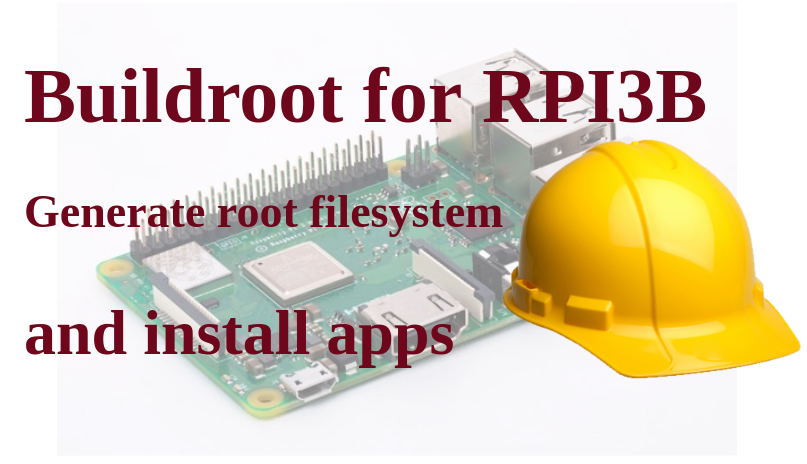Install the apps using Buildroot for Raspberry Pi 3 Model B
Share on:Edit on:Table of Contents
- Introduction
- Download the Buildroot
- Configure the Buildroot system
- Download the patch to fix the compilation issue
- Generate the root filesystem
- Extract the root filesystem
- Install Linux kernel modules
- Copy root filesystem to SD card
- Change U-boot env values
- Reboot the board
Introduction
In the earlier article, we have successfully booted the Embedded Linux system we created by compiling toolchain, U-boot, Linux and root filesystem individually. But there are so many useful applications missing, like the ssh server and client programs.
In this tutorial we will use a build system called Buildroot to see how to install other useful applications to the root filesystem. The Buildroot itself is a tool to generate toolchain, Linux kernel and root filesystem combiningly. But we are going to use it to generate the root filesystem with the other useful apps. Here I am going to take dropbear which is very small ssh server and client program. We are going to install dropbear into the root filesystem, copy the files to the SD card and boot the board.

Download the Buildroot
Download the build system from the official website.
cd ~/rpi3/
wget -c https://buildroot.org/downloads/buildroot-2020.02.2.tar.gz
tar xvf buildroot-2020.02.2.tar.gz
Configure the Buildroot system
Go to the extracted Buildroot directory and configure the following options by running make menuconfig
cd ~/rpi3/buildroot-2020.02.2/
make menuconfig
- Select Target options -> Target Architecture -> Aarch64 (Little endian)
- Select Toolchain -> Toolchain type -> External toolchain. The overall build time will be reduced as we are not going to compile the toolchain again.
- Select Toolchain -> Toolchain -> Custom toolchain
- Select Toolchain -> Toolchain path. And enter the path to the toolchain. Ex: /home/USERNAME/x-tools/aarch64-rpi3-linux-gnu
- Select Toolchain -> Toolchain has SSP support
- Select Toolchain -> Toolchain has RPC support
- Select Toolchain -> Toolchain prefix -> $(ARCH)-rpi3-linux-gnu
- Select Toolchain -> External toolchain kernel headers series -> 4.19.x or later.
- Select Toolchain -> External toolchain C library -> glibc/eglibc
- Select Target packages -> Networking applications -> dropbear
- Select System configuration -> Root password. Enter the new password. We will use this password to login to the board console later.
Download the patch to fix the compilation issue
You might see the following compile time error during compilation.
date.c:(.text.date_main+0x21c): undefined reference to `stime'
collect2: error: ld returned 1 exit status
Note: if build needs additional libraries, put them in CONFIG_EXTRA_LDLIBS.
Download the patch to fix the above compile time error.
curl https://www.nayab.xyz/patches/0003-compile-error-fix-stime.patch --output ~/rpi3/buildroot-2020.02.2/package/busybox/0003-compile-error-fix-stime.patch
Generate the root filesystem
Generate the root filesystem using the following command.
make -j`nproc`
The generated new filesystem is present as a tar file in the path ~/rpi3/buildroot-2020.02.2/output/images
Extract the root filesystem
Extract the root filesystem tar file in some other directory.
mkdir -p ~/rpi3/nfs_tmp
tar -C ~/rpi3/nfs_tmp/ -xvf ~/rpi3/buildroot-2020.02.2/output/images/rootfs.tar
Install Linux kernel modules
Install the already compiled Linux modules into newly created root filesystem by running below commands.
cd ~/rpi3/linux
export ARCH=arm64
export CROSS_COMPILE=aarch64-rpi3-linux-gnu-
export PATH=$PATH:~/x-tools/aarch64-rpi3-linux-gnu/bin/
make modules_install INSTALL_MOD_PATH=~/rpi3/nfs_tmp/
Copy root filesystem to SD card
Insert the SD card into the system and copy the newly generated filesystem into /dev/mmcblk0p2 partition. Unmount the partition if it is mounted already and then format the partition using the following command.
sudo mkfs.ext4 /dev/mmcblk0p2 -L rootfs
Remove and insert again in the system so that the mount point is /media/USERNAME/rootfs. Otherwise it would be different if you manually mount it. lsblk command will help you to find mount point of partition.
Copy rootfs files to SD card.
# Copy from rootfs directory to SD card
sudo cp -r ~/rpi3/nfs_tmp/. /media/<USERNAME>/rootfs/
Replase UERENAME with yours. The copied root filesystem files have binaries and init scripts to start ssh server automatically.
If you want to add any additional packages, do make menuconfig in the buildroot directory, select the required packages and follow the same steps mentioned in this post.
Change U-boot env values
Power up the board. Stop at the U-boot console and add the following env variables to load RPI from SD card.
setenv bootargs earlyprintk root=/dev/mmcblk0p2 rootfs=ext4 rootwait noinitrd
setenv bootcmd 'mmc dev 0; fatload mmc 0:1 0x2000000 kernel.img; fatload mmc 0:1 0x200000 bcm2710-rpi-3-b.dtb; booti 0x2000000 - 0x200000;'
saveenv
Reboot the board
Insert the SD card into Raspberry Pi card slot and reboot the board. You should be able to login to the Raspberry Pi using SSH from your system.
If you are unable to login, it’s likely that the Ethernet interface is not up in the board. You can make link up and assign some static IP using following commands in the baord.
ifup -a
ifconfig eth0 192.168.1.120
Now you should be able to login using the following command from your system. Enter your Root password when prompted.
ssh root@192.168.1.120